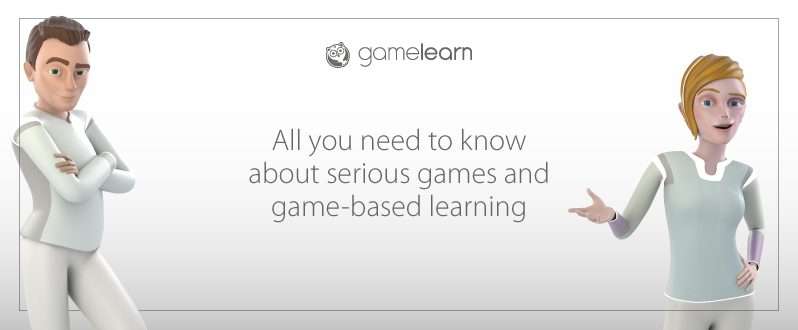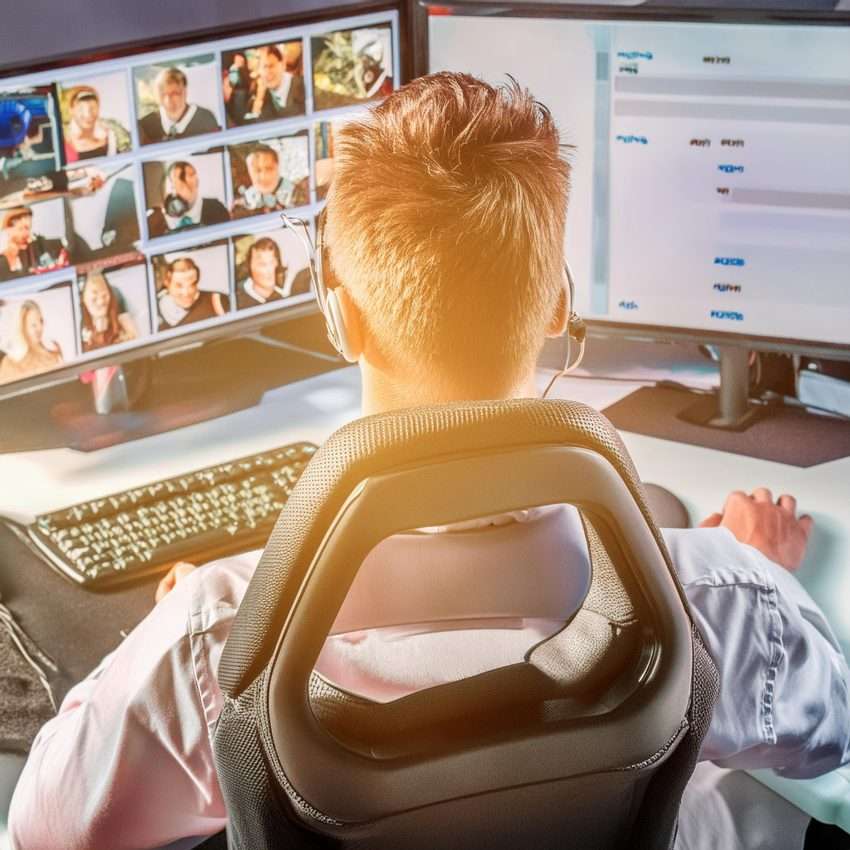At first sight, putting words like “serious” and “game” together might seem impossible, but it’s not. In recent years, serious games have proven that it is possible to learn while you play. This teaching method is known as game-based learning, a trend that’s expanding at the speed of light in primary schools, prestigious universities and large corporations. In this post, we’re going to tell you all you need to know about serious games and learning through video games, including their main characteristics and benefits, and a few prime examples.
What is a serious game?
Serious games are games whose primary objective is NOT fun or entertainment, rather learning or practicing a skill. Its use has grown, particularly in such sectors as education, defense, aeronautics, science or health. Its purpose can be one of many: from training firefighter crews in emergency situations to training a sales team, teaching mathematics or practicing a language.
Example 1: Dragon Box Elements
In the field of education, one of the most simple (and effective) games is Dragon Box Elements. Here, players have to build an army, defeat the evil dragon Osgard and save Euclid’s island. Designed for kids of nine years-of-age and upwards, to manage all that, they have to learn basic geometry and the theorems of Euclid himself. Dragon Box is a good example of a serious game: the students learn math while they have fun with a video game.
What is game-based learning?
The method that uses video games for learning purposes is known as game-based learning. The key lies in the fact that the content and the skills that you want to teach are not put across in a face-to-face class or in a book but rather through video games. Advocates of this innovative method of teaching think that video games can be a fun and effective tool at one and the same time, reducing the costs of training programs, increasing student motivation and facilitating direct practice. The star products of game-based learning are precisely, serious games.
Example 2: Pulse!!
The healthcare sector has enthusiastically welcomed this innovative method of teaching. The expert in nursing, Claudia Johnston, based herself on first-person shooting video games (such as Quake or Duke to develop Pulse!!, which reproduces the conditions of an emergency ward in a hospital. Thanks to this video game, future nurses can practice all they have learnt in their theoretical classes and gain experience handling real situations. The goal of the players is to identify each patient’s problem, giving priority to the most serious cases and applying the appropriate measures depending on each person’s condition.
The 5 elements of a serious game
It’s no easy task to create a serious game: it requires a lot of talent, a lot of time and a lot of money. Although there is a huge variety of formats and objectives, most game-based learning systems tend to have five elements that ensure they work properly and are effective:
1 – A story. Although it is by no means essential, most video games have a plot or a main story. It may be a prince risking life and limb to rescue a princess or a brave soldier who has to put paid to his enemy. Or, as we have seen, it may also be a nurse who has to save a patient’s life. The more sophisticated the argument (and the characters), the easier it will be to motivate the players and for them to get into the game.
Example 3: Pacific
The video game Pacific starts just there, with a story: while on a humanitarian mission, a team’s plane crashes and they are trapped on an island in the middle of the Pacific Ocean. The player’s objective is to lead their team while they build a hot-air balloon so that they can escape from the island and return home safe and sound. To do so, they have to learn all the virtues of a good leader and team manager (skills that every company is calling out for), including motivating and rewarding their colleagues, resolving conflicts, delegating tasks or coaching them. That’s the only way they can hope to get off the island.
2 – Gamification. The second fundamental element of any serious game are the game dynamics, which include the rankings, rewards, badges or points systems. This gamification tends to animate and motivate the players: we all love to get more coins, obtain more lives or pass through to the next level (remember Mario Bros?). Classifications or rankings are also very important in serious games: healthy competition with our classmates or work colleagues encourage us to try that bit harder and to do everything possible to beat our rivals.
Example 4: Duolingo
Many of these elements can be seen in the famous language application, Duolingo. While users learn English, Spanish, French or German, they receive points, go up to the next level, lose lives or outdo their friends and relations. Each lesson they learn has a reward. Even though Duolingo is not strictly speaking a serious game, it is one of the most successful applications when it comes to using gamification elements for learning.
3 – Immediate and individualized feedback. As opposed to face-to-face courses (normally with dozens of people in the classroom and one single teacher), serious games offer immediate and personalized feedback. The player interacts directly with the game and instantly receives a reward or a punishment. In the most sophisticated video games, this feedback is also detailed and argued: users can know where they have gone wrong and can try to do better next time. If properly imparted, this feedback can be a powerful learning tool.
4 – Simulation. In most cases, serious games reproduce or imitate real life situations. Using fictitious characters and by recreating scenarios, players find themselves immersed in a world similar to the one they will find beyond the screen of their computer or their cell phone. These simulators make it possible for users to interact with a new reality and to practice the skills and concepts they have acquired during the game.
Example 5: The Virtual Interactive Combat Environment (VICE)
Simulators have been used to great effect when training surgeons, aircraft pilots or military personnel. The most outstanding institution in this latter field is undoubtedly the United States Defense Department, probably the public body which has dedicated most money and resources to game-based learning in the last number of decades. One of its best-known video games is The Virtual Interactive Combat Environment (VICE), which uses a sophisticated 3D simulator to allow military personnel to practice conflict resolution, how to use regulatory equipment, communicate with the rest of the team or act in a war scenario.
5 – The goal: to learn. We’ll not tire of repeating it: the key element of serious games is that their purpose is to teach something. All the elements we’ve mentioned above can be found in endless commercial video games, but that does not necessarily make them serious games. As well as using all these elements, serious games also have to have a purpose that is not recreational and that almost always has to do with a certain educational or training aspect.
What are the advantages of game-based learning and serious games?
When all the above elements are combined successfully, we have a powerful learning tool. The use of a narrative, gamification techniques, simulators and feedback during the teaching process imply numerous benefits when compared to face-to-face learning or e-learning. These are the five most outstanding advantages:
1 – They increase engagement and motivation
We’ve all suffered some of the negative aspects of traditional education: long hours sat listening to a teacher, endless theories laid out in a book and next to no interaction with the content matter. Whether we’re talking about adolescents in a school or workers in a company, the lack of motivation and engagement in students is one of the major concerns of teachers and HR managers.
Serious games and game-based learning are two of the best solutions to this problem. Video games are necessarily interactive and users have to make decisions from the word go. Game dynamics encourage effort and the narrative they are wrapped up in serves to motivate the students. The most sophisticated video games can even turn learning into an addiction. As they explain in the book The Gamification of Learning and Instruction Fieldbook, “The more the learner interacts with other learners, the content, and the instructor, the more likely it is that learning will actually occur.”
Example 6: Our City
Millennials (both in school and at work) are one of the sectors where it can prove hardest to achieve engagement. To solve that problem, in Jordan they have developed a video game on Facebook called “Our City”, which seeks to get people between 15 and 24 involved in their local communities, enhance their social behavior and invite them to take part in the life of the city. The game, which has certain similarities with the popular The Sims, makes young people mayors, and it allows them to build the city from scratch while keeping all the townspeople happy at the same time. Some of the challenges they face include developing basic public services (such as health or education) and improving the transport in the city.
2 – They facilitate profound reflection
Quite often, particularly in the labor world, we work in a humdrum and repetitive environment where we prioritize the most urgent tasks one day and the next. This makes it hard to strategically plan for the long term, and it prevents us from reflecting in any profound way on the challenges and opportunities we are facing. Serious games, thanks to how they can immerse us in other worlds and whisk us away from reality, can provide just the distance we need to encourage in-depth reflection and thoughts.
3 – They facilitate real and safe practice
As opposed to face-to-face training, game-based learning is a form of learning that is based on practice. Thanks to the simulators, the players can interact with other characters and they can use the knowledge they have gained from the outset. Serious games also offer the best of both worlds: on the one hand, the simulators should reproduce reality as faithfully as possible; on the other hand, the fact that it is a video game allows users to practice in safety without any risk of personal harm or material damage. This is particularly important if we are talking about operating in a surgery or flying a plane.
Example 7: Merchants
Real and direct practice is also vital in the corporate world. As is the case with the video game Merchants (part of the Gamelearn platform), which trains employees in any manner of company in how to negotiate and in how to resolve conflicts. In Merchants, the players are transported to the Venice of the late 15th century. Here they have to endeavor to build their commercial empire and to face up to tough negotiators such as Machiavelli. This video game allows the employees of a multinational to handle difficult negotiations that they can then apply in the real world, but without their company having to pay the price of any errors that are part and parcel of any learning process.
4 – They improve memorization and retention
One of the advantages of serious games is that by increasing the engagement and the motivation of the students, they also increase their memorization and retention of what they have learnt. Add to this real and direct practice and the result is that the students learn better and more deeply. Several scientific studies have proven that learning by doing makes a more effective and long-lasting impact on students’ brains.
5 – They make the world a better place
That may well sound overly ambitious, but the fact is that several serious games have also been so bold as to attempt to change the world. The fact that we like gamification and simulators can be a good tool for encouraging empathy, promoting peace, defending people’s rights or spreading civic values. As opposed to the stereotype by which video games are a cause of antisocial or violent behavior, the reality is that game-based learning can encourage prosocial and positive attitudes for society as a whole.
Example 8: Food Force
In 2005, the United Nations World Food Programme developed a video game to promote social awareness and the fight against hunger. In the video game (Food Force) the players put themselves in the shoes of a UN rookie, who has to handle a crisis involving famine and civil war on an island in the Pacific. The player’s goal is to distribute food among the populace and to help the country to become self-sufficient in the medium to long term. A fantastic example of how serious games can make the world a better place.
The success of serious games and game-based learning
All these benefits have placed game-based learning at the vanguard of the revolution in education that the world of teaching and corporative training is experiencing at the moment. Many of these more or less sophisticated video games are used every day by millions of people (in many cases, without their even realizing it). For example, in the United Kingdom, most players (33%) prefer video games to puzzles, word games or trivial pursuits. Although not all of them can be considered serious games, it is a good indicator of the growing acceptance of game-based learning throughout the world.
Serious games are also a very serious business. According to estimates made by the consultancy Marketandmarkets, this sector will grow between 2015 and 2020 at an average annual rate of 16.38%, which will mean that last year the business will have reached 5.449 billion dollars. There is a growing demand for learning through video games and little by little, the market is responding to that demand.
The reasons why game-based learning is so popular, are becoming much more well known: as we have seen, they improve student engagement and motivation, they afford direct practice without risk, and they facilitate the memorization and retention of knowledge. While serious games have been around for centuries (let’s not forget that ever since we were small we’ve all been learning as we play), the social and technological changes of recent years are extending game-based learning to the four corners of the planet. Whether it is to improve the training of nurses, to help primary school kids learn geometry or to promote leadership skills among the employees of a company, serious games have become one of the most practical and effective teaching tools in the world today.





